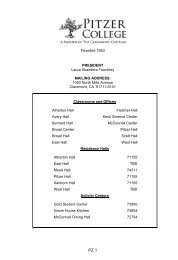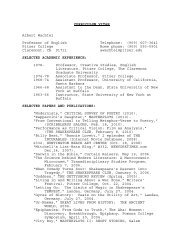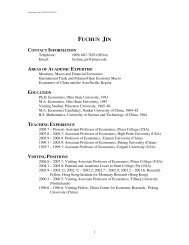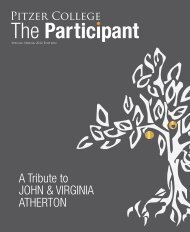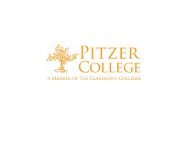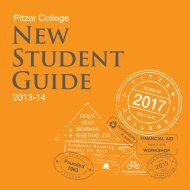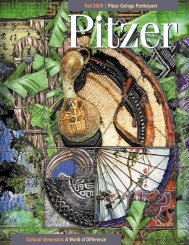2006 Annual Report of Excellence - Pitzer College
2006 Annual Report of Excellence - Pitzer College
2006 Annual Report of Excellence - Pitzer College
You also want an ePaper? Increase the reach of your titles
YUMPU automatically turns print PDFs into web optimized ePapers that Google loves.
<strong>Pitzer</strong> <strong>College</strong> <strong>of</strong>fers an innovative<br />
liberal arts education focused on a deeper<br />
understanding <strong>of</strong> humankind within a<br />
governance structure that allows every<br />
voice to be heard equally and fully.<br />
<strong>Pitzer</strong> <strong>College</strong> creates a purposeful and<br />
meaningful environment in which students<br />
learn to lead proactive and exemplary lives<br />
within the global community. <strong>Pitzer</strong>’s<br />
interdisciplinary approach to the applied<br />
liberal arts serves as an exemplar <strong>of</strong><br />
educational ingenuity. <strong>Pitzer</strong>’s excellence<br />
is recognized, praised and supported by<br />
educational leaders, college guides and<br />
philanthropic foundations nationwide.<br />
Featured on the Cover<br />
The stained glass window, located at the entrance to a garden<br />
patio dedicated to former Board <strong>of</strong> Trustees Chair Susan Pritzker,<br />
was created by <strong>Pitzer</strong> <strong>College</strong> President Laura Skandera Trombley<br />
and her husband artist Nelson Trombley. The orange tree is an<br />
iconic symbol <strong>of</strong> <strong>Pitzer</strong> <strong>College</strong>, which was founded by citrus<br />
grower and philanthropist Russell K. <strong>Pitzer</strong>.<br />
<strong>Pitzer</strong> <strong>College</strong> | 1
pitzer college<br />
Core Values<br />
Academic <strong>Excellence</strong><br />
Social Responsibility<br />
Diverse Community<br />
Intercultural Understanding<br />
our<br />
Mission<br />
<strong>Pitzer</strong> <strong>College</strong> produces engaged, socially responsible citizens <strong>of</strong><br />
the world through an academically rigorous, interdisciplinary<br />
liberal arts education emphasizing social justice, intercultural<br />
understanding and environmental sensitivity. The meaningful<br />
participation <strong>of</strong> students, faculty and staff in college governance<br />
and academic program design is a <strong>Pitzer</strong> core value. Our<br />
community thrives within the mutually supportive framework<br />
<strong>of</strong> The Claremont <strong>College</strong>s, which provides an unsurpassed<br />
breadth <strong>of</strong> academic, athletic and social opportunities.<br />
one <strong>of</strong> america’s<br />
Best <strong>College</strong>s<br />
<strong>Pitzer</strong> <strong>College</strong> is ranked 36th <strong>of</strong> 215 liberal arts<br />
colleges in academic reputation and as having<br />
the 38th lowest acceptance rate among the toptier<br />
liberal arts colleges, according to U.S.News<br />
& World <strong>Report</strong>.<br />
<br />
<strong>Pitzer</strong> <strong>College</strong> has begun the largest construction project since its<br />
founding with new residence halls that are socially and environmentally<br />
responsible and that are being built to the strict standards<br />
<strong>of</strong> the U.S. Green Building Council. The <strong>College</strong> stands<br />
positioned to become one <strong>of</strong> the first colleges in the nation to<br />
replace all <strong>of</strong> its residence halls with LEED (Leadership in<br />
Energy & Environmental Design) gold-certified residence halls.<br />
<br />
Laura Skandera Trombley<br />
President <strong>of</strong> <strong>Pitzer</strong> <strong>College</strong><br />
Eighteen <strong>Pitzer</strong> <strong>College</strong> students received prestigious Fulbright<br />
Program Fellowships in <strong>2006</strong>, a national record for colleges its<br />
size, totaling thirty-four awards for the past three years. Other<br />
student awards for <strong>2006</strong> included a Harry S. Truman scholar, a<br />
Thomas J. Watson fellow, a McNair scholar, a Coro fellow, a<br />
Kemper Foundation scholar, a Jack Kent Cooke Foundation<br />
graduate scholar, and a Rotary International Ambassadorial<br />
scholar. >>><br />
<strong>Pitzer</strong> <strong>College</strong> | 3
more on one <strong>of</strong> america’s<br />
Best <strong>College</strong>s<br />
<strong>Pitzer</strong> ranks as the fifth most diverse private coeducational toptier<br />
liberal arts college in America by U.S. News, with<br />
students <strong>of</strong> color representing 32 percent <strong>of</strong> the student body.<br />
<br />
According to U.S. News, <strong>Pitzer</strong> ranks 21st in the top tier <strong>of</strong> 110<br />
liberal arts schools for the percentage <strong>of</strong> students studying<br />
abroad. <strong>Pitzer</strong> <strong>College</strong>’s thirty-five international and domestic<br />
exchange programs make it possible for students to study<br />
abroad for more than one semester.<br />
<br />
<strong>Pitzer</strong> <strong>College</strong> is one <strong>of</strong> seventy-six colleges or universities that<br />
has been selected by The Carnegie Foundation for their new<br />
elective Community Engagement Classification.<br />
<br />
<strong>Pitzer</strong> is included in The Princeton Review’s The Best 361<br />
<strong>College</strong>s, which named the <strong>College</strong> as one <strong>of</strong> the “Best in the<br />
West.” <strong>Pitzer</strong> was one <strong>of</strong> 129 schools pr<strong>of</strong>iled in the first edition<br />
<strong>of</strong> The Best Western <strong>College</strong>s, and one <strong>of</strong> five pr<strong>of</strong>iled in the<br />
regional guidebook series.<br />
<br />
<strong>Pitzer</strong> <strong>College</strong> is one <strong>of</strong> the nation’s most effective schools fostering<br />
social responsibility and public service, according to The<br />
Princeton Review and Campus Compact. <strong>Pitzer</strong> <strong>College</strong> is one<br />
<strong>of</strong> eighty-one institutions in thirty-three states that The<br />
Princeton Review commends and features in its book, <strong>College</strong>s<br />
with a Conscience: 81 Great Schools with Outstanding Community<br />
Involvement.<br />
In Kaplan Publishing’s The Un<strong>of</strong>ficial, Unbiased Insider’s Guide<br />
to the 328 Most Interesting <strong>College</strong>s, <strong>Pitzer</strong> is cited as <strong>of</strong>fering<br />
“the most creative curriculum <strong>of</strong> all The Claremont <strong>College</strong>s.”<br />
<br />
The <strong>College</strong> is a member <strong>of</strong> the Consortium for Innovative<br />
Environments in Learning (CIEL), a group <strong>of</strong> the most progressive<br />
colleges working to reinvigorate American higher education.<br />
<br />
<strong>Pitzer</strong> is cited by the National Wildlife Foundation as one <strong>of</strong><br />
the foremost schools in the country for Environmental Studies.<br />
<br />
The Fiske Guide to <strong>College</strong>s lauds <strong>Pitzer</strong>’s strong Media Studies<br />
program.<br />
<br />
The Claremont <strong>College</strong>s Debate Union, in which <strong>Pitzer</strong> students<br />
participate, ranked eighth out <strong>of</strong> four hundred teams at<br />
the national debate championship.<br />
<br />
<strong>Pitzer</strong> <strong>of</strong>fers ten men’s and ten women’s intercollegiate athletic<br />
teams. <strong>Pitzer</strong> students also participate in The Claremont<br />
<strong>College</strong>s Club sports programs, which compete nationally.<br />
<br />
<strong>Pitzer</strong> has the nation’s third best faculty, eighth most politically<br />
active students, and was ranked eighth for lots <strong>of</strong> race/class<br />
interaction in The Princeton Review’s The Best 361 <strong>College</strong>s.<br />
4 | <strong>Report</strong> <strong>of</strong> <strong>Excellence</strong><br />
<strong>Pitzer</strong> <strong>College</strong> | 5
outstanding<br />
Joint Science Program<br />
<strong>Pitzer</strong>, Claremont McKenna and Scripps <strong>College</strong>s share an interdisciplinary<br />
Joint Science Department housed in the state-<strong>of</strong>-theart<br />
W. M. Keck Science Center. From 2002 to <strong>2006</strong>, nearly 78<br />
percent <strong>of</strong> Joint Science students who applied were admitted to<br />
medical school. By contrast, the national average acceptance rate<br />
is 43 percent.<br />
exceptional<br />
Media Studies Program<br />
<strong>Pitzer</strong> <strong>College</strong> is the lead Claremont <strong>College</strong> for Media Studies.<br />
<strong>Pitzer</strong>’s own Media Studies program appeals to socially committed<br />
artists and showcases grass-roots filmmaking at its best.<br />
Pr<strong>of</strong>essor Jesse Lerner was awarded a Fulbright-Garcia Robles<br />
Fellowship for <strong>2006</strong>–07. Films by three <strong>Pitzer</strong> Media Studies<br />
pr<strong>of</strong>essors have been featured at the Sundance Film Festival.<br />
Other works by <strong>Pitzer</strong> pr<strong>of</strong>essors: Alexandra Juhasz and Jesse<br />
Lerner co-edited F is for Phony, a study on fake documentary<br />
practice and theory (Minneapolis: University <strong>of</strong> Minnesota<br />
Press); Alexandra Juhasz made “Video Remains,” an experimental<br />
video in the film festival circuit; and Ming-Yuen Ma was a<br />
Surdna Foundation Distinguished Visiting Artist in Film and<br />
Visual Arts, California State Summer School for The Arts<br />
(CSSSA).<br />
TOP: A student conducts research in a laboratory in the W. M. Keck Science Center.<br />
BOTTOM: Media Studies student Zachary Miller ’09 won a 2007 Jeep Compass in a video commercial<br />
competition as well as second prize from Paramount Studios for his screenplay about HIV and AIDs and<br />
the teen community.<br />
<strong>Pitzer</strong> <strong>College</strong> | 7
major<br />
Student Awards<br />
<strong>Pitzer</strong> student awards earned from 2001 to <strong>2006</strong>:<br />
Forty-four Fulbright Program Fellowships<br />
Four Thomas J. Watson Fellowships<br />
Two Freeman Foundation Asia Fellowships<br />
Four Rotary Ambassadorial Scholarships<br />
One Woodrow Wilson Foundation Fellowship<br />
One Morris K. Udall Foundation Native American<br />
Congressional Internship<br />
Four Coro Fellowships<br />
Three Kemper Foundation Scholarships<br />
One Jack Kent Cooke Foundation Graduate Scholarship<br />
Two American Sociological Association Minority Fellowships<br />
One Teaching Assistantship Fellow from the French government<br />
(selected by the Institute <strong>of</strong> International Education)<br />
One Rudolph Polk Memorial Award in Music<br />
<strong>Pitzer</strong> students enjoy a strong tradition <strong>of</strong> receiving major<br />
fellowships and scholarships. One <strong>Pitzer</strong> student has received<br />
the Rhodes scholarship and six additional students have been<br />
finalists. In <strong>2006</strong>, eighteen <strong>Pitzer</strong> <strong>College</strong> students were awarded<br />
Fulbright grants to continue in their fields <strong>of</strong> study—a<br />
record for colleges <strong>of</strong> fewer than one thousand students for the<br />
fourth consecutive year. Since 1997, <strong>Pitzer</strong> students have won<br />
five Thomas J. Watson Fellowships, seven Rotary<br />
Ambassadorial Scholarships, six Freeman Foundation Asia<br />
Fellowships, five American Sociological Association Minority<br />
Fellowships (the highest number among colleges and universities<br />
in the U.S.), one Morris K. Udall Foundation Native<br />
American Congressional Internship, and one Woodrow Wilson<br />
Foundation Fellowship.<br />
The Grove House, a California Arts and Crafts bungalow, was saved from potential demolition when it was<br />
moved to <strong>Pitzer</strong> <strong>College</strong> in 1977 as a class project. Now the Grove House serves as a popular gathering<br />
place.<br />
<strong>Pitzer</strong> <strong>College</strong> | 9
highly<br />
Selective<br />
<strong>Pitzer</strong> <strong>College</strong> had the 38th lowest acceptance rate among the<br />
top-tier liberal arts colleges for its Fall 2005 entering class,<br />
according to U.S. News rankings. Fewer than thirty national<br />
liberal arts colleges have acceptance rates less than 40 percent<br />
as <strong>Pitzer</strong> did in Fall 2005. The 2005–06 academic year set an<br />
all-time record for number <strong>of</strong> applications to <strong>Pitzer</strong>, and<br />
showed an increase for the eighth consecutive year.<br />
year in review<br />
Sports<br />
Women’s soccer won the Southern California Intercollegiate<br />
Athletic Conference (SCIAC) Championship and advanced to<br />
the NCAA Championships for the first time in program<br />
history. Men’s Cross Country won their third consecutive<br />
Conference Championship. The football team ranked first in<br />
the Conference in pass defense and second in total defense.<br />
Women’s s<strong>of</strong>tball recorded the most wins ever this year in<br />
school history. Women’s tennis finished second in the<br />
Conference and qualified for the NCAA Regionals. A men’s<br />
tennis doubles team recorded wins over the first and third<br />
ranked doubles teams in the country. The golf team was<br />
undefeated in dual matches in the Conference. The women’s<br />
water polo team finished second in the Conference.<br />
TOP: Students enjoy studying outdoors in the beautiful Southern California weather.<br />
BOTTOM LEFT: The Sagehen football team ranked first in the Conference in pass defense and second in<br />
total defense.<br />
BOTTOM RIGHT: The Sagehen women’s soccer team won the Southern California Intercollegiate Athletic<br />
Conference (SCIAC) Championship and advanced to the NCAA Championships for the first time in program<br />
history.<br />
<strong>Pitzer</strong> <strong>College</strong> | 11
innovative<br />
Community Service & Outreach<br />
<strong>Pitzer</strong> <strong>College</strong>’s focus on social responsibility and community<br />
service provides students with a plethora <strong>of</strong> volunteer opportunities<br />
on and <strong>of</strong>f campus. Among the many programs <strong>of</strong>fered<br />
through the Center for California Cultural and Social Issues<br />
(CCCSI), <strong>Pitzer</strong> students have the opportunity to conduct<br />
reading groups with women in recovery, tutor homeless and<br />
at-risk young children, or help juvenile <strong>of</strong>fenders improve their<br />
literacy skills at area probation camps. CCCSI is also home to<br />
the <strong>Pitzer</strong> in Ontario (California) program, which <strong>of</strong>fers a<br />
fifteen-hour per week internship, rigorous training in applied<br />
research methods, and a theoretical and topical framework<br />
through which to understand pressing social and urban issues<br />
in the Southern California region.<br />
<strong>Pitzer</strong> <strong>College</strong> faculty <strong>of</strong>fer course-related projects in communitybased<br />
Spanish; early academic outreach; and the Leadership in<br />
Environmental Education Partnership (LEEP). Another<br />
community service program is Jumpstart, a national nonpr<strong>of</strong>it<br />
outreach program that pairs college students with preschool-age<br />
children struggling in the areas <strong>of</strong> communication, literacy and<br />
social skills. The highly successful Jumpstart pilot program<br />
begun at <strong>Pitzer</strong> in 1999 has become the model for other<br />
programs at universities throughout the United States.<br />
<strong>Pitzer</strong> is also one <strong>of</strong> fifteen California International Studies<br />
Project (CISP) locations, funded by the State <strong>of</strong> California to<br />
support the development <strong>of</strong> public school teachers through<br />
collaboration with faculty in social sciences and world history.<br />
There are thirty-six current and former Peace Corps volunteers<br />
who are alumni <strong>of</strong> <strong>Pitzer</strong> <strong>College</strong>. <strong>Pitzer</strong> <strong>College</strong> was invited to<br />
become one <strong>of</strong> ten colleges forming the founding core <strong>of</strong> the<br />
national Project Pericles, which encourages liberal arts colleges to<br />
turn rhetoric into action by training students to be responsible<br />
citizens.<br />
Leadership in Environmental Education Partnership (LEEP) trains <strong>Pitzer</strong> students in principles <strong>of</strong> environmental<br />
education so they can serve as instructors to children from elementary schools. At left, an elementary school<br />
student participates in an activity at the Bernard Field Station.<br />
<strong>Pitzer</strong> <strong>College</strong> | 13
Class <strong>of</strong> <strong>2006</strong> Attending Graduate<br />
and Pr<strong>of</strong>essional School by Fields <strong>of</strong> Study<br />
Humanities<br />
and Social Services<br />
15%<br />
Communications<br />
9%<br />
Sciences/Math/Engineering<br />
3% Health Care<br />
9%<br />
Education<br />
18%<br />
Business<br />
7%<br />
Law<br />
9%<br />
Class <strong>of</strong> <strong>2006</strong> Who are Employed<br />
by Field <strong>of</strong> Employment<br />
Retail<br />
15%<br />
Education<br />
26%<br />
Government<br />
4%<br />
Nonpr<strong>of</strong>its and<br />
Social Services<br />
15%<br />
Recreation 3%<br />
Business<br />
23%<br />
Science 5%<br />
Arts<br />
9%<br />
14 | <strong>Report</strong> <strong>of</strong> <strong>Excellence</strong><br />
<strong>Pitzer</strong> <strong>College</strong> | 15
alumni<br />
Doctorates<br />
In the most recent data reported by the National Science<br />
Foundation, <strong>Pitzer</strong> <strong>College</strong> ranked 8th in the number <strong>of</strong> alumni<br />
who pursued a PhD in psychology, 29th in the number <strong>of</strong><br />
alumni who pursued a PhD in anthropology, and 38th in the<br />
number <strong>of</strong> alumni who pursued a PhD in sociology out <strong>of</strong> 154<br />
private colleges and universities.<br />
alumni attend prestigious<br />
Graduate Universities<br />
<strong>Pitzer</strong> <strong>College</strong> graduates have been accepted at the following<br />
prestigious institutions: Cambridge University; Columbia<br />
Medical School; Cornell University; Duke University;<br />
Georgetown University; Harvard University; Massachusetts<br />
Institute <strong>of</strong> Technology; Northwestern University; New York<br />
University; Princeton University; Rice University; Rutgers<br />
University; Smith <strong>College</strong>; Stanford University; Tufts<br />
University; University <strong>of</strong> California, Berkeley; University <strong>of</strong><br />
Chicago; University <strong>of</strong> California, Davis; University <strong>of</strong><br />
California, Los Angeles; University <strong>of</strong> Michigan; University <strong>of</strong><br />
Southern California; Vanderbilt University; Washington<br />
University; and Yale University.<br />
Los Angeles Mayor Antonio Villaraigosa was<br />
the keynote speaker for the <strong>2006</strong> Fabian<br />
Núñez ’97 Scholarship Benefit held at<br />
Univision corporate<br />
headquarters in L.A.<br />
notable<br />
Alumni<br />
<strong>Pitzer</strong> <strong>College</strong> graduates are prepared to take on life’s challenges<br />
while making a difference in their communities. <strong>Pitzer</strong>’s<br />
many impressive alumni include diverse individuals with varied<br />
careers such as:<br />
Arts<br />
Susan Patron ’69, Winner <strong>of</strong> the American Library<br />
Association’s John Newbery Medal for her children’s book The<br />
Higher Power <strong>of</strong> Lucky;<br />
Matt Baer ’86, Producer <strong>of</strong> films such as City by the Sea, Jack<br />
Frost and The Replacement Killers;<br />
Matthew Cooke ’96, Editor and Producer <strong>of</strong> the Academy<br />
Award nominated documentary film Deliver Us from Evil;<br />
Jessica Hurley ’92, Emmy Award winner <strong>of</strong> Best<br />
Documentary for A Dose <strong>of</strong> Reality and Gold Mike Award<br />
winner for Best Documentary as producer, writer and host <strong>of</strong><br />
Life Lessons, Truths and Consequences;<br />
Deborah Shelton ’78, Co-producer for CNN and <strong>2006</strong><br />
recipient <strong>of</strong> the National Headliner Award for her article<br />
“Lives on the Line.”<br />
Science and Research<br />
Stuart Goldstein ’86, Medical Director <strong>of</strong> the Renal Dialysis<br />
Unit at Texas Children’s Hospital and Associate Pr<strong>of</strong>essor <strong>of</strong><br />
Pediatrics at Baylor <strong>College</strong> <strong>of</strong> Medicine;<br />
Sue Celniker ’75, Research Scientist and Co-director <strong>of</strong> the<br />
Drosophila Genome Center at Lawrence Berkeley<br />
Laboratories;<br />
Thomas Perls ’82 MD, MPH, Associate Pr<strong>of</strong>essor <strong>of</strong><br />
Medicine and Geriatrics at Boston University’s Alzheimer’s<br />
Disease Center. >>><br />
16<br />
<strong>Pitzer</strong> <strong>College</strong> | 17
Nonpr<strong>of</strong>it<br />
Hunter Lovins ’72, President and Founder <strong>of</strong> Natural<br />
Capitalism, Inc. and named “Hero <strong>of</strong> the Planet” by Time<br />
Magazine in 2000;<br />
Kirsten Grønbjerg ’68, Recipient <strong>of</strong> the 2005 Award for<br />
Distinguished Achievement and Leadership in Nonpr<strong>of</strong>it and<br />
Voluntary Action Research from the Association for Research<br />
on Nonpr<strong>of</strong>it Organizations and Voluntary Action (ARNOVA);<br />
Thomas Brock ’83, Director <strong>of</strong> Young Adults and<br />
Postsecondary Education Policy Area for Manpower<br />
Demonstration Research Corporation (MDRC);<br />
Judith Treas ’69, President-elect <strong>of</strong> the Pacific Sociological<br />
Association (PSA).<br />
Public Service<br />
Fabian Núñez ’97, Speaker <strong>of</strong> the California State Assembly;<br />
Emily Stevens ’71 and Yvonne Sanchez ’78, L.A. Superior<br />
Court judges;<br />
Debra Yang ’81, the first Asian American to be named U.S.<br />
Attorney for the Central District <strong>of</strong> California (the largest<br />
federal prosecutor’s <strong>of</strong>fice outside Washington DC);<br />
Kevin de León ’03, California State Assemblyman representing<br />
the 45th Assembly District.<br />
Business<br />
Lance Auder ’87, Vice President <strong>of</strong> the Bank Supervision<br />
Group for the Federal Reserve Bank <strong>of</strong> New York;<br />
Bridget Baker ’82; President, Television Networks<br />
Distribution, NBC Universal;<br />
Nancy Goldfarb Pope ’78, Vice President <strong>of</strong> Human<br />
Resources for EMI Music Marketing;<br />
John Landgraf ’84, President and General Manager <strong>of</strong> FX<br />
Networks;<br />
JoAnn Copperud ’73, CEO <strong>of</strong> RGA Environmental, provider<br />
<strong>of</strong> environmental and health and safety services.<br />
national<br />
Grants<br />
<strong>Pitzer</strong> <strong>College</strong> has received grants and contributions from<br />
foundations, corporations, and government agencies, among<br />
which are the Ahmanson Foundation, Atlantic Philanthropies<br />
(USA) Inc., the Avery Arts Foundation, the R. Stanton Avery<br />
Foundation, the Corella and Bertram F. Bonner Foundation,<br />
the Booth Ferris Foundation, the Arthur Vining Davis<br />
Foundations, the Christian A. Johnson Endeavor Foundation,<br />
the Freeman Foundation, the John Randolph Haynes and<br />
Dora Haynes Foundation, the William Randolph Hearst<br />
Foundation, the William and Flora Hewlett Foundation, the<br />
U.S. Department <strong>of</strong> Housing and Urban Development<br />
(HUD), the James Irvine Foundation, the Fletcher Jones<br />
Foundation, the James S. Kemper Foundation, the Kresge<br />
Foundation, the Henry Luce Foundation, the 3M Foundation,<br />
the Andrew W. Mellon Foundation, the National Science<br />
Foundation, the Bernard Osher Foundation, the Ralph M.<br />
Parsons Foundation, the Ann Peppers Foundation, the Mabel<br />
Wilson Richards Scholarship Fund, the John Stauffer<br />
Charitable Trust, and the Weingart Foundation.<br />
In <strong>2006</strong>, <strong>Pitzer</strong>’s Residential Life Project was significantly<br />
advanced through a $750,000 challenge grant from the Kresge<br />
Foundation.<br />
18 | <strong>Report</strong> <strong>of</strong> <strong>Excellence</strong><br />
<strong>Pitzer</strong> <strong>College</strong> | 19
selected faculty<br />
Publications<br />
Bill Anthes, Assistant Pr<strong>of</strong>essor <strong>of</strong> Art<br />
History, Native Moderns: American Indian<br />
Painting, 1940–1960. Durham: Duke<br />
University Press, <strong>2006</strong>.<br />
Dipa Basu, Pr<strong>of</strong>essor <strong>of</strong> Sociology, The<br />
Vinyl Ain’t Final: Hip Hop and the<br />
Globalization <strong>of</strong> Black Popular Culture.<br />
(London: Pluto Press, <strong>2006</strong>), co-edited with<br />
Sid Lemelle, was published in the U.S. by<br />
the University <strong>of</strong> Michigan Press, <strong>2006</strong>.<br />
Nigel Boyle, Pr<strong>of</strong>essor <strong>of</strong> Political Studies,<br />
Crafting Change: Labor Market Policy under<br />
Mrs Thatcher. New Orleans: University<br />
Press <strong>of</strong> the South, 2005.<br />
Carmen Fought, Associate Pr<strong>of</strong>essor <strong>of</strong><br />
Linguistics, Language and Ethnicity.<br />
London: Cambridge University Press,<br />
<strong>2006</strong>.<br />
Tom Ilgen, The Jones Foundation<br />
Pr<strong>of</strong>essor <strong>of</strong> Political Studies, Hard Power,<br />
S<strong>of</strong>t Power and the Future <strong>of</strong> Transatlantic<br />
Relations. Editor. Aldershot, UK: Ashgate<br />
Press, <strong>2006</strong>.<br />
Brian Keeley, Pr<strong>of</strong>essor <strong>of</strong> Philosophy,<br />
Paul Churchland. Series: Contemporary<br />
Philosophy in Focus. Editor. Cambridge:<br />
Cambridge University Press, 2005.<br />
Ronald Macaulay, Pr<strong>of</strong>essor <strong>of</strong> Linguistics<br />
Emeritus, The Social Art: Language and its<br />
Uses. Second edition. Oxford University<br />
Press, <strong>2006</strong>.<br />
Ntongela Masilela, Pr<strong>of</strong>essor <strong>of</strong> English<br />
and World Literature, The Cultural<br />
Modernity <strong>of</strong> H.I.E. Dhlomo. Trenton, NJ:<br />
Africa World Press, <strong>2006</strong>.<br />
Peter Nardi, Pr<strong>of</strong>essor <strong>of</strong> Sociology, Doing<br />
Survey Research (Boston: Allyn & Bacon<br />
<strong>2006</strong>) and Interpreting Data: A Guide to<br />
Understanding Research (Boston: Allyn &<br />
Bacon, 2004).<br />
Thomas Poon, Pr<strong>of</strong>essor <strong>of</strong> Chemistry,<br />
Introduction to Organic Chemistry. Spanish<br />
translation. With W. Brown. Hoboken, NJ:<br />
John Wiley and Sons, Inc., <strong>2006</strong>.<br />
20 | <strong>Report</strong> <strong>of</strong> <strong>Excellence</strong><br />
<strong>Pitzer</strong> <strong>College</strong> | 21
faculty<br />
Recognition<br />
Kersey Black (Chemistry), Newton H. Copp (Biology),<br />
Gretchen Edwalds-Gilbert (Biology), Scot A. Gould<br />
(Physics), K. Purvis-Roberts (Chemistry) were co-PIs on the<br />
National Science Foundation Grant for “Increasing Science<br />
Graduates Through Interdisciplinary Teaching and Research.”<br />
2005–09 ($498,700).<br />
G. Edwalds-Gilbert (Biology), J. Higdon (Physics),<br />
K. Purvis-Roberts (Chemistry) received an Andrew W. Mellon<br />
Foundation Grant for “Enhancement <strong>of</strong> Environmental Science<br />
at the Joint Science Department.” 2005–08 ($285,000).<br />
David Furman (Art) was featured in Who’s Who in American<br />
Art, <strong>2006</strong>.<br />
Judith V. Grabiner (Mathematics) received the prestigious<br />
Lester R. Ford Award from the Mathematical Association <strong>of</strong><br />
America, for best article(s) in the American Mathematical<br />
Monthly, 2005.<br />
Mary Hatcher-Skeers (Chemistry) received an NIH Academic<br />
Research Enhancement Award for $170,000. The title <strong>of</strong> the<br />
grant is “Dynamic 31P NMR <strong>of</strong> Backbone Dynamics in<br />
DNA.”<br />
Jim Hoste (Mathematics) was appointed Chair <strong>of</strong> the<br />
Committee on the Pr<strong>of</strong>ession, American Mathematical Society,<br />
<strong>2006</strong>–07.<br />
Jesse Lerner (Media Studies) received a Director’s Choice<br />
award at the Black Maria Film Festival for his work, “T.S.H.,”<br />
<strong>2006</strong>.<br />
John Norvell (Anthropology-Visiting) received a Fulbright<br />
Faculty Grant for teaching and research in Boa Vista, Brazil,<br />
Fall <strong>2006</strong>. The title <strong>of</strong> his project was “Urban Indians and<br />
Caboclo Whites: Social Identity in the Brazilian Amazon.”<br />
Dan Segal (Anthropology and History) was the honored<br />
lecturer at The Page-Barbour Lectures at the University <strong>of</strong><br />
Virginia. His series <strong>of</strong> three lectures was titled, “Modernity and<br />
the History Monopoly, or Why We Need Other Histories.”<br />
Peter Nardi (Sociology) was elected president <strong>of</strong> the Pacific<br />
Sociological Association (PSA) for the term beginning April<br />
2005. >>><br />
Martha Barcenas-Mooradian, visiting instructor <strong>of</strong> Spanish, takes the classroom outdoors.<br />
<strong>Pitzer</strong> <strong>College</strong> | 23
more faculty<br />
Recognition<br />
Maria Soldatenko (Gender and Feminist Studies and<br />
Chicano/a Studies) was elected National Association for<br />
Chicana and Chicano Studies (NACCS) Chicana Caucus Chair<br />
for 2003–05.<br />
John D. (Jack) Sullivan (Political and Environmental Studies)<br />
was elected Legislation Director for the League <strong>of</strong> Women<br />
Voters <strong>of</strong> California.<br />
Zhaohua Irene Tang (Biology) received two significant<br />
grants: an NSF-RUI grant for “Cell-cycle Regulation <strong>of</strong> LAM-<br />
MER-related Kinases” from the NSF Program <strong>of</strong> Signal<br />
Transduction/Cell Regulation (2005–08; $340,000) and a<br />
NIH AREA grant (2005–07; $197,154).<br />
Andre Wakefield (History) received the Arnold L. and Lois S.<br />
Graves Award in the Humanities (ACLS) for “The Edinburgh<br />
Synergy.” Edinburgh, Scotland (<strong>2006</strong>) and the Herzog Ernst<br />
Fellowship, Thyssen Foundation, for “Leibniz in the Mines.”<br />
Gotha, Germany (<strong>2006</strong>).<br />
Emily Wiley (Biology) received a National Science<br />
Foundation CAREER grant, “Investigating Heterochromatin<br />
Assembly through Histone Deactylases.” ($652,630).<br />
Phil Zuckerman (Sociology) was appointed associate editor<br />
for the journal Sociology <strong>of</strong> Religion.<br />
TOP: Halford Fairchild, Pr<strong>of</strong>essor Psychology and Black Studies, engages in a<br />
discussion with a student.<br />
BOTTOM: Susan Phillips, director <strong>of</strong> <strong>Pitzer</strong>’s Center for California Cultural and Social Issues, teaches a<br />
class.<br />
24 | <strong>Report</strong> <strong>of</strong> <strong>Excellence</strong>
nationally recognized<br />
Intercultural & Language<br />
Education Programs<br />
Through the study <strong>of</strong> language, culture and firsthand experience<br />
in communities worldwide, <strong>Pitzer</strong>’s Study Abroad programs<br />
integrate constructive learning with social responsibility.<br />
Beginning with the <strong>Pitzer</strong> in Nepal program in 1974, <strong>Pitzer</strong><br />
<strong>of</strong>fers programs in Botswana, China, Ecuador, India, Italy,<br />
Japan and Costa Rica. <strong>Pitzer</strong> <strong>College</strong> <strong>of</strong>fers thirty-five exchange<br />
programs in Argentina, Australia, Bulgaria, Canada, Denmark,<br />
England, Finland, France, Germany, Ghana, Hungary, Ireland,<br />
Japan, Korea, Latvia, Mexico, Morocco, South Africa, Spain,<br />
Thailand, Turkey and the United States.<br />
The majority <strong>of</strong> graduating seniors in <strong>2006</strong> participated in<br />
Study Abroad programs.<br />
<br />
In 2005–06, <strong>Pitzer</strong> students studied in twenty-seven countries<br />
and studied twenty-one languages.<br />
<br />
In 2000, <strong>Pitzer</strong> initiated the first community-based Spanish<br />
program in the country. The program integrates intensive<br />
classroom instruction with practical learning experiences in the<br />
local Spanish-speaking community.<br />
<br />
<strong>Pitzer</strong> <strong>of</strong>fers individualized instruction in Less Commonly<br />
Taught Languages (LCTL’s) before going abroad (Turkish,<br />
Finnish, Zulu, and Thai).<br />
<br />
<strong>Pitzer</strong>’s Program in American <strong>College</strong> English (PACE) trains<br />
international students in intensive academic English and<br />
American studies, and is recognized by the American<br />
Association <strong>of</strong> Intensive English Programs (AAIEP), the Japan<br />
Foundation for International Education (JFIE), the Latin<br />
American Scholarship Program for American Universities<br />
(LASPAU at Harvard), and the Embassy <strong>of</strong> the United Arab<br />
Emirates as one <strong>of</strong> the most effective language programs in the<br />
United States.<br />
A <strong>Pitzer</strong> <strong>College</strong> student chats with the grandmother <strong>of</strong> her host family during her <strong>Pitzer</strong> in Darjeeling study<br />
abroad program.<br />
<strong>Pitzer</strong> <strong>College</strong> | 27
a strong<br />
Financial Future<br />
<strong>Pitzer</strong> <strong>College</strong>’s fundraising efforts continued to set records in<br />
2005–06. Led by generous members <strong>of</strong> the Board <strong>of</strong> Trustees,<br />
more than 3,100 alumni, parents, faculty and staff, friends, and<br />
organizations contributed to the <strong>College</strong> for a wide range <strong>of</strong><br />
vital projects. The number <strong>of</strong> donors at the President’s Circle<br />
level ($1,000 and above) has increased by 59 percent during<br />
the past five years, while total contributions to the <strong>Annual</strong><br />
Fund have increased by 32 percent, reaching an all-time high<br />
in 2005–06 <strong>of</strong> $1,436,000 raised in a single year.<br />
<strong>Pitzer</strong> is currently raising funds for the Residential Life Project,<br />
which includes nearing the completion <strong>of</strong> three residence halls<br />
and programming to improve the on-campus experience for<br />
students. In 2005–06, the <strong>College</strong> raised $3,700,000 in new<br />
pledges for the project, bringing the total funds raised to date<br />
to more than $15 million <strong>of</strong> the anticipated $18 million goal.<br />
Mirroring the financial security realized through a maturing<br />
fundraising program, the <strong>College</strong>’s endowment has also experienced<br />
significant growth during the past five years, increasing<br />
by 83 percent to its current market value <strong>of</strong> $86.3 million in<br />
spite <strong>of</strong> significant market volatility. This growth is attributed<br />
to a combination <strong>of</strong> new gifts to support the endowment as<br />
well as careful attention to prudent, long-term investment<br />
strategies. <strong>Pitzer</strong> also realized substantial growth in <strong>2006</strong> when<br />
it received its largest gift to date—$15 million from the estate<br />
<strong>of</strong> Roger C. Holden, one <strong>of</strong> the <strong>College</strong>’s early trustees.<br />
Collective gifts received throughout the year help the <strong>College</strong><br />
achieve key initiatives such as strengthening its academic<br />
programs and funding student scholarships.<br />
28 | <strong>Report</strong> <strong>of</strong> <strong>Excellence</strong>


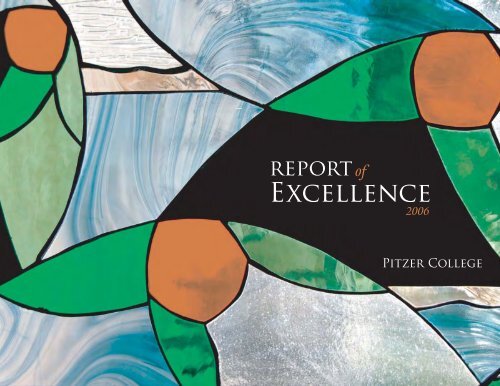
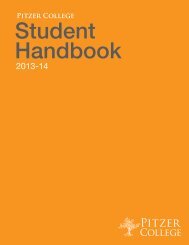

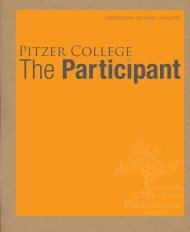
![Anticipated Courses SP14 [pdf] - Pomona College](https://img.yumpu.com/25363335/1/190x245/anticipated-courses-sp14-pdf-pomona-college.jpg?quality=85)

